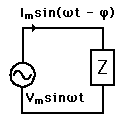AC Ohm's Law
The AC analog to Ohm's law is

where Z is the impedance of the circuit and V and I are the rms or effective values of the voltage and current. Associated with the impedance Z is a phase angle, so that even though Z is the also the ratio of the voltage and current peaks, these peaks do not occur at the same time. The phase angle is necessary to characterize the circuit and allow the calculation of the average power used by the circuit.
 
|
AC circuit concepts
| HyperPhysics***** Electricity and Magnetism | R Nave |